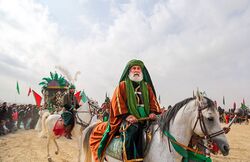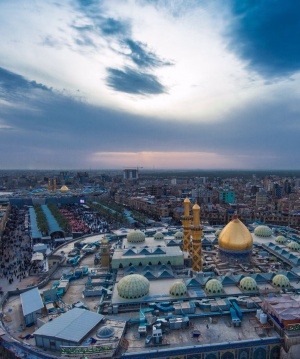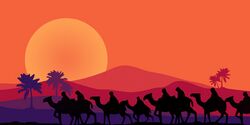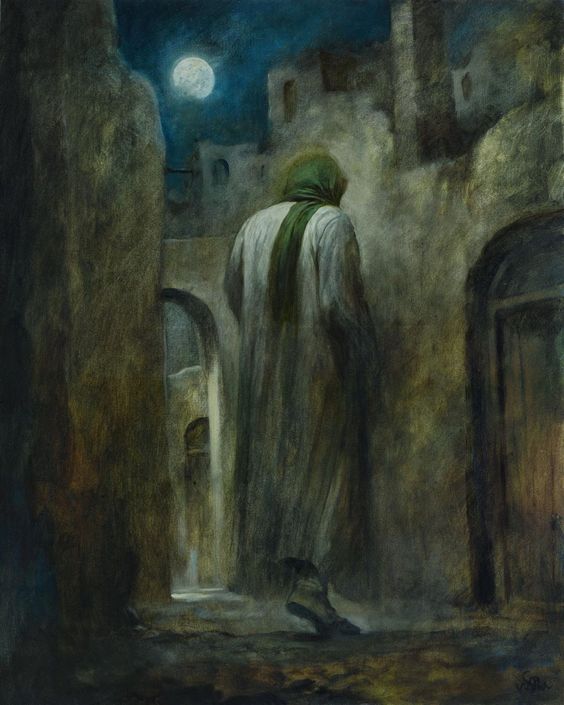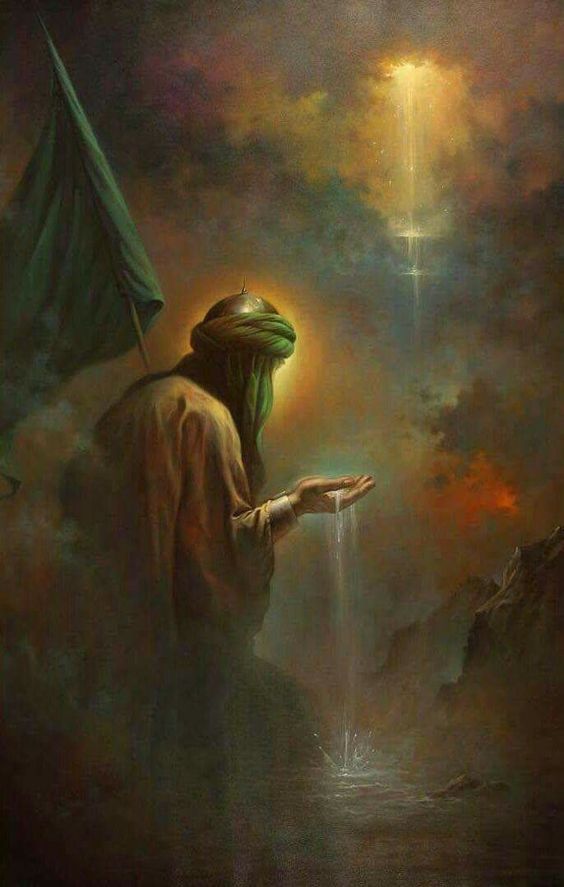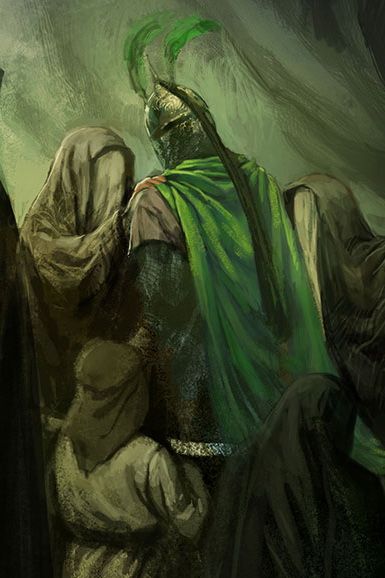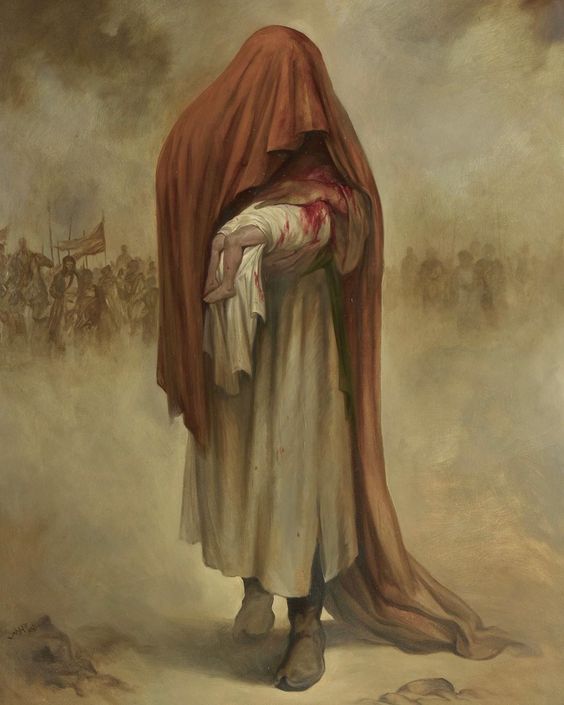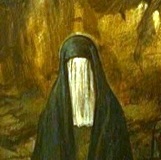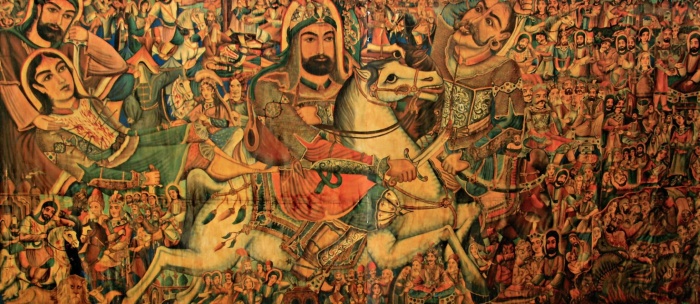- Who was the youngest martyr of Karbala?
- When did the Ziarat Arba’een date back?
- Why did Imam Hasan abdicate the Caliphate to Muawiya?
- How many people were killed during Wahhabis’ attack at Karbala?
- In Ta’ziya (pictured), who is shown testing and training Ali al-Akbar before the Battle?
- Is Ashura considered a day of fasting by Sunnis?
- How many of martyrs of Karbala were descendants of Banu Hashim?
Main Page: Difference between revisions
No edit summary |
No edit summary |
||
| (99 intermediate revisions by 7 users not shown) | |||
| Line 1: | Line 1: | ||
{{mainpage/top | |||
| color = fff | |||
| link 1 = [[Literature]] | |||
| link 2 = [[Geography]] | |||
| link 3 = [[Art]] | |||
| link 4 = [[History]] | |||
| link 5 = [[Religions and Denominations]] | |||
| link 6 = [[An Enchanted Modern|Cultural Studies]] | |||
}} | |||
<div class="portal-container-4"> | |||
{{Featured Index | |||
| class = portal-column-2-4 | |||
| style = grid-column-start: 1; grid-column-end: span 2; grid-row-start: 1; grid-row-end: span 2; | |||
| image=Al-Hurr ibn Yazid(2).jpg | |||
| imagesize = 250px | |||
| text = The first meeting between [[Horr|Horr B. Yazid al-Riahi al-Yarbuʾi al-Tamimi]] and Imam Hussain was not hostile. However, Horr pressed upon Hussain to change his course and follow him, even after the latter had informed him of the letters of support, he had received from the Kufans, towards whom his party was heading. Horr further obeyed Ibn-e Ziad’s subsequent order to force the rebels to stop in a deserted area. Thus, Hussain was led to the plain of Karbala, where he was encircled by the troops dispatched by Ibn-e Ziad under the command of ʿOmar b. Saʿd. Once the latter had rejected Hussain’s final proposals and decided to fight him on the morning of Ashura, 10 Muharram 61/10 October 680, Horr then repented and joined Hussain, who promised him God’s forgiveness. | |||
[[Horr B. Yazid al-Riahi al-Yarbuʾi al-Tamimi|Full Article...]] | |||
}} | |||
{{did you know | |||
| class = portal-column-2-4 | |||
| style = grid-column-start: 1; grid-column-end: span 2; gr id-row-start: 1; grid-row-end: span 2; | |||
| image =Ta'ziya in Arba’een.jpg | |||
| imagesize = 250px | |||
| text =* [[Ali Asqar ibn Hussain|Who was the youngest martyr of Karbala?]] | |||
* [[Arba’een#Historical_Background|When did the Ziarat Arba’een date back?]] | |||
* [https://en.wikihussain.com/view/Hasan_B._%CA%BFAli_B._Abi_Taleb#Confronting_Mu.CA.BFawiya_Army Why did Imam Hasan abdicate the Caliphate to Muawiya?] | |||
* [[Karbala#Karbala_Under_Wahhabi_Attack|How many people were killed during Wahhabis’ attack at Karbala?]] | |||
* [[Ali_al-Akbar_ibn_al-Hussain#Commemoration_and_Shi.E2.80.99a_Rituals|In Ta’ziya (pictured), who is shown testing and training Ali al-Akbar before the Battle?]] | |||
* [http://Shi%CA%BFa#Umayyad_and_Abbasid_Periods Is Ashura considered a day of fasting by Sunnis?] | |||
* [[Ziara#Benefits_of_Ziara|How many of martyrs of Karbala were descendants of Banu Hashim?]] | |||
}} | |||
{{Featured | |||
| class = portal-column-1-4 | |||
| style = grid-column-start: 3; grid-row-start: 1; grid-row-end: span 1; | |||
| image =City of Karbala in Iraq.jpg | |||
| imagesize = 300px | |||
| text = [[Shahada]] {{vline}} [[Ahl Al-Bayt]] {{vline}} [[Karbala]] (pictured) {{vline}} [[Ta'ziya]] {{vline}} [[Ziara]] {{vline}} [[Fatima]] | |||
}} | |||
{{Works | |||
| class = portal-column-1-4 | |||
| style = grid-column-start: 3; grid-row-start: 2; grid-row-end: span 3; | |||
| image = | |||
| imagesize = 200px | |||
| text = The “[[Picture-storyteller Masters of Iran]]” was written by Hamid Reza Ardalan, musician and scholar of ritual arts of Iran, in thirty volumes. This work introduces thirty Pardekhans who are among the remaining generation of picture-storytellers.This book is the result of ten years of library research and field work of the author. Each volume of this series is around 25 picture pages and includes an introduction and analysis of one of the picture-storytellers. The book and CD, as a contribution to preserving ritual arts and oral heritage of Iran, have been published by “Farhagestan-e Honar” in both English and Persian languages. | |||
[[Picture-storyteller Masters of Iran|Full Article...]] | |||
}} | |||
{{Path of Imam al-Husain|class = portal-column-1-4|style = grid-column-start: 4; grid-row-start: 1; grid-row-end: span 4;}} | |||
</div> | |||
{{CirclePersons | |||
| image1 = Muslim b aqil.jpg | |||
| title1 = [[Muslim b. ʿAqil b. Abi Talib|Muslim b. ʿAqil]] | |||
| image2 = Abbas b ali.jpg | |||
| title2 = [[Abbas B. ʿAli B. Abu Taleb|Abbas B. ʿAli]] | |||
| image3 =Ali akbar2.jpg | |||
| title3 = [[Ali al-Akbar ibn al-Hussain|Ali al-Akbar]] | |||
| image4 = Ali asghar.jpg | |||
| title4 = [[Ali Asqar ibn Hussain|Ali Al-Asqar]] | |||
| image5 = Zaynab bint Ali.jpg | |||
| title5 = [[Zaynab]] | |||
}} | |||
{{Featured art big | |||
| image = Mirza ali khandan 10.jpg | |||
| imagesize = 700px | |||
| text = The curtain used by [[Mirza ali khandan|murshed Khandan]], is illustrated by Ostad Hossein Hamedani, and dates back more than 50 years. The length of the curtain (Parde) is about 4 metres, and is one of the largest of its kind. The Parde has many faces and gatherings painted upon it. | |||
}} | |||
{{Featured indexes | |||
| main title = Indexes | |||
| column 1 title = Individuals | |||
| column 1 category 1 = Historical Characters | |||
| column 1 category 2 = Ahl al-Bayt | |||
| column 1 category 3 = Martyrs of Karbala | |||
| column 1 category 4 =Scholars | |||
| column 2 title = Periods and Historic Events | |||
| column 2 category 1 = Battle of Karbala | |||
| column 3 title = Rituals | |||
| column 3 category 1 = Mourning Rituals | |||
| column 3 category 2 = Ritual Dramatic Art | |||
| column 4 title = Geographical Span | |||
| column 4 category 1 =Places | |||
| column 4 category 2 = Islamic Architecture | |||
| column 5 title =Works | |||
| column 5 category 1 =Written Works | |||
|column 3 category 3=Ziarat|column 2 category 2=Sermons|column 3 category 4=Supplications|column 5 category 2=Books}} | |||
{{mainpage/footer }} | |||
__NOTOC__ | __NOTOC__ | ||
[[fa:صفحهٔ_اصلی]] | [[fa:صفحهٔ_اصلی]] | ||
[[fr:]] | |||
Latest revision as of 12:09, 22 February 2023
Welcome to Wikihussain
Article choisi
 The first meeting between Horr B. Yazid al-Riahi al-Yarbuʾi al-Tamimi and Imam Hussain was not hostile. However, Horr pressed upon Hussain to change his course and follow him, even after the latter had informed him of the letters of support, he had received from the Kufans, towards whom his party was heading. Horr further obeyed Ibn-e Ziad’s subsequent order to force the rebels to stop in a deserted area. Thus, Hussain was led to the plain of Karbala, where he was encircled by the troops dispatched by Ibn-e Ziad under the command of ʿOmar b. Saʿd. Once the latter had rejected Hussain’s final proposals and decided to fight him on the morning of Ashura, 10 Muharram 61/10 October 680, Horr then repented and joined Hussain, who promised him God’s forgiveness.
Full Article...
The first meeting between Horr B. Yazid al-Riahi al-Yarbuʾi al-Tamimi and Imam Hussain was not hostile. However, Horr pressed upon Hussain to change his course and follow him, even after the latter had informed him of the letters of support, he had received from the Kufans, towards whom his party was heading. Horr further obeyed Ibn-e Ziad’s subsequent order to force the rebels to stop in a deserted area. Thus, Hussain was led to the plain of Karbala, where he was encircled by the troops dispatched by Ibn-e Ziad under the command of ʿOmar b. Saʿd. Once the latter had rejected Hussain’s final proposals and decided to fight him on the morning of Ashura, 10 Muharram 61/10 October 680, Horr then repented and joined Hussain, who promised him God’s forgiveness.
Full Article...
Did you know
Featured art Works
Stations on the path of Imam Hussain
| Date | Station |
|---|---|
| 8th Dhu l-Hijja |
|
| 9th Dhu l-Hijja | |
| 10th Dhu l-Hijja |
|
| 14th Dhu l-Hijja | |
| 15th Dhu l-Hijja |
|
| 18th Dhu l-Hijja | |
| 19th Dhu l-Hijja | |
| 26th Dhu l-Hijja | |
| 27th Dhu l-Hijja | |
| 28th Dhu l-Hijja | |
| 2nd Muharram |
